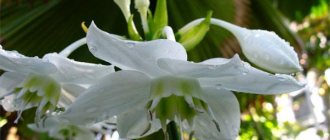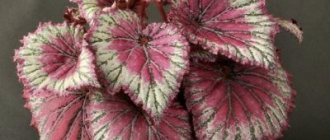Crinum or lily, as it is also called, is a beautiful plant that belongs to the Amaryllis family. The flower's homeland is tropical and subtropical lands .
The culture develops best on sea coasts, near lakes, rivers and reservoirs. In nature, there are many varieties of crinum, photos of which can be viewed below.
Main types
Abyssinian crinum (crinum abyssinicum)
The bulb of this species can grow up to 7 cm in diameter. Leaves are medium sized. They are rough and reach 45 cm in length . Peduncle of impressive size.
The umbrella inflorescence consists of a maximum of 6 buds. The flowers grow on short stalks .
Their petals are elongated and snow-white. Important! American crinum is also very popular in winter gardens. It is rarely planted in apartments due to its enormous size.
Crinum moorei
The plant has a large bulb, up to 20 cm in diameter. The leaves are belt-shaped, slightly wavy. There are veins in . The peduncle is large and dense. It is painted in a rich green shade.
The inflorescence consists of 6-10 buds, which, when blooming, create a colorful bouquet. The stamens are small. They are located below the petals and have a red tint .
Powell's crinum (crinum x powellii)
It is often also called krinum ledi. This is a hybrid variety that was bred by breeders. The bulb has a perfectly flat surface . Its diameter does not exceed 15 cm. The leaves are large.
Adult plates reach 1 m, belt-shaped. The flowers have a diameter of about 15 cm. They exude a pleasant fragrant aroma.
Crinum bulbispermum or Cape crinum capense
The bulb grows in the form of a bottle. The leaf blades are narrow and long. They are rough on top, green with a gray tint . When open, the buds take on a white or whitish-purple tone. Flowering can be observed from July to August.
Meadow crinum (crinum pratense)
Leaves are elongated. There can be from 6 to 8 of them on each bush The umbrella inflorescence consists of 6-12 buds. The stamens are large and red. The homeland of Krinum meadow is the lands of Eastern India.
Reddish crinum (crinum erubescens aiton)
The bulb is in the shape of an oval. It has a thickness of up to 10 cm. The length of the leaves reaches 90 cm and the width is 8 cm. The peduncle is long, up to 90 cm high . The flowers are snow-white, inside and outside they have a reddish or pinkish tint. Flowering begins in summer.
Crinum amabile
The leaves are also belt-shaped. There can be up to 30 of them on one bush. Inflorescences consist of buds of the same number. The flowers are bright, have a red tint with a white or purple tint.
During flowering, a pleasant aroma is present near the plant, which lasts until the end of flowering.
Crinum campanulatum
The bulb is presented in the shape of a small oval. The leaves are straight with a groove in the middle. The edges are pointed. Each plate grows up to 120 cm long. The inflorescence is located on a peduncle , the length of which does not exceed 2 cm.
Each umbrella contains from 4 to 8 medium-sized buds. The flowers below are reddish-white with a greenish tint. Some parts of them have a pinkish or even yellowish tone.
Majestic crinum (crinum augustum)
This variety has a lot of leaf blades. They are all belt-shaped. Plates grow up to 90 cm long and about 10 cm wide. The inflorescences consist of 20 buds. Reddish petals on the sides. The stamens themselves are of the same tone.
Crinum majestic blooms in summer. In the wild, it can only be seen on the slopes of the mountains of the island of Mauritius. It is an excellent option for growing in winter gardens and greenhouses.
Large crinum (crinum giganteum)
The plant is distinguished by a huge bulb with an incredibly short neck. The leaves are tilted down. They have a green tint with a pronounced yellowish pattern. The length of the peduncle is about 100 cm . It has a rich green tint.
The flowers are white and exude a pleasant, rich aroma that fills everything around. The throat of the flower is in the shape of a bell. The stamens are light, but much shorter than the petals themselves. Large crinum blooms in the summer.
Asian crinum (crinum asiaticum)
The leaves of this species are entire at the edges. Outwardly, they resemble thin belts. One bush can have from 20 to 30 plates. The inflorescences are presented in the form of an umbrella of 20-50 buds .
When loosened, they do not emit a scent . The petals are white with red stamens. Asian crinum blooms from March to October.
Crinum scabrum
Large bulb with a short neck. Deciduous plates are distinguished by slight waviness in the lower part. Inflorescences consist of 4-8 buds.
Ceylon crinum (crinum zeylanicum)
This species is native to the lands of Africa and Asia. The inflorescences consist of 20 buds of the same size. The bouquet is located on a long and thin stem . The leaves are massive. There are few of them on one bush, up to 10 pieces.
Crinum virgineum or virginicum
The flower's homeland is the lands of Southern Brazil. The plant prefers warm and humid air. The bulb is huge. It has a rich brown hue. The leaves are narrow and long.
Veins can be observed on their surface . The buds are collected in the form of inflorescences. Each of them contains up to 6 flowers. The buds bloom in mid-autumn.
Crinum pedunculatum
Its homeland is the northern part of Australia. The leaf blades are small. They are distinguished by a light green tint. The flowers are colorful and medium in size. The buds bloom in December . The bulb is small. She has a short neck.
Crinum macowanii
In the wild, this species can only be found on the slopes of the Natal mountains. The flowers are collected in voluminous umbrellas. Each of them can have up to 20 buds . The root system is presented in the form of a round bulb.
It can reach 25 cm in diameter. Flowering occurs in late autumn.
Crinum latifolium
The plant is distinguished by large, belt-shaped leaf blades. They all have a rich green tint. Inflorescences with an umbrella. The buds are located close to each other , thus creating a beautiful bouquet.
The flowers are on short, thin stalks . Broadleaf crinum blooms in the second part of August or early September.
Characteristic
The time has passed when flower growers only had hippeastrums on their windowsills. Now krinums are gaining popularity. After all, they have flowers of such attractive sizes and such different shades. It is difficult to find a plant that would differ in the same shapes.
However, to see such beauty in your room, you need to provide careful care. Only if all conditions are met is it possible that those long-awaited buds will appear.
Bulbous plants are difficult to care for. Many people know this. That's why they are afraid to start a krinum. However, if you read a little about its growing conditions, you can understand that, despite the fact that it is also a bulbous plant, it is not considered demanding.
This plant is considered quite large in relation to other representatives of bulbous plants. The second name for krinum is krin. Translated from Latin it means “hair”. A more poetic name for the plant is pink lily. It belongs to the Amaryllis family.
While some believe that this plant is an ornamental flowering plant. Others argue that it belongs to the decorative deciduous family. In fact, kreen have characteristics of both types.
We recommend that you read the article: Tolmia Menzisa: care at home.
General characteristics:
- His neck is quite elongated. Its length varies from sixty to ninety centimeters.
- In terms of size, the crinum bulb is classified as large. After all, its diameter reaches twenty-five centimeters.
- The roots are very powerful and superficial. If you see that the root system is even crawling out of the soil, then you should not draw premature conclusions. This is not a lack of land. This is simply a feature of this plant.
- Krinum has a pseudostem.
- Many leaves. In their shape they are lanceolate-linear. They are quite long (usually more than one meter), so they fall beautifully.
- If the leaves are still young, they are rolled into tubes.
The flowering period begins in early spring and ends only in autumn. At this time, you can see how buds appear on the peduncles, and then flowers bloom, the diameter of which reaches fifteen centimeters.
The flowers can easily be confused with a lily. They are the same shape. However, the shades are slightly different. Krinum alternates between white and pink. The smell is not strong, but quite pleasant.
Seeds can only appear if the flower is artificially pollinated. At the same time, it is interesting to note that if the seeds do appear, then you will notice that in addition to them, there will also be water in the box. It will be enough for the seeds to germinate.
Caring for indoor crinum at home
In order for the crinum indoor plant to always be neat and delightful with colorful buds, you need to follow simple rules of care. This is the only way to achieve the desired results for both experienced gardeners and those who have just begun to get involved in growing ornamental crops.
Important! The brighter the light, the more colorful the inflorescences will be.
So, the basic rules for caring for a plant:
Lighting
The flower develops well only in those rooms that are well heated by the sun. During the dormant period, the pot with the plant must be placed in a cooler place so that it does not have a lot of light.
Important! It is best to grow crinum on southern windows. But, at lunchtime, the flower should be shaded, otherwise its leaves will get sunburn.
Temperature
In spring, the plant should be kept indoors, where the indicators are in the range of 17-220C. In winter, the temperature should be lowered to +70C.
In summer, the flowerpot with the plant can be taken out into the fresh air, but care must be taken to ensure that the sun's rays do not fall on it. As for air humidity, there are no special requirements for this. The bush feels good under different indicators.
Watering rules: how to make crinum bloom
In order for crinum to delight with colorful buds in open ground, it must be irrigated every day. This also applies to indoor specimens . But you shouldn’t flood the bush either. This can negatively affect both its flowering and its overall appearance.
Use only well-settled and warm water for irrigation. To activate the flowering process, you need to stop watering for a week or two, but then resume it again.
How to feed crinum
The flower should be fertilized with special mixtures that are sold in stores. To fertilize crinum, only liquid formulations are used. They must be applied twice a month.
The first procedure is carried out when new leaves appear . You should stop fertilizing the plant after the flowers begin to fade.
Care during rest
Immediately after flowering, the plant must be placed in a cool place and the amount of watering reduced. If this is not done, then the crinum will not bloom next year.
Soil mixture for growing in a pot
You can either buy soil for planting or prepare it yourself. To make a soil mixture, you will need to take two parts clay and one part each of peat, humus, sand and deciduous soil . You can also add a small amount of charcoal.
Advice! If the air in the room is dry, then the leaves must be systematically sprayed or wiped with a damp cloth.
Optimal temperature
South African species are grown in cool greenhouses. They will be able to survive our winters in gardens, but before the cold weather it is necessary to insulate the root system with straw and fallen leaves. In winter, shovel snow.
The ambient temperature for the flower in spring and summer is 22-27 degrees Celsius. In winter, physiological development continues at 2-6 degrees.
Any air humidity is suitable. It is better to spray water with a sprayer. Also wipe the leaves with a damp cloth.
How to plant and replant indoor crinum in a pot
The flowerpot and soil for adult specimens should be changed once every 3-4 years. This should only be done when the plant is resting. Planting is carried out in such a way that the bulb is half above the soil level.
Only a deep container is used for krinum. This is due to a well-developed root system. A layer of drainage should be laid at the bottom of the flowerpot, which can be used as crushed red brick, pebbles or expanded clay.
This video shows how Asian crinum blooms and how to replant the plant correctly.
Recommendations for planting in open ground
Krinum garden flower is intended for open ground. Before planting, you need to study the characteristics of the plant and its preferences. To grow a crop, you need to create optimal growing conditions:
- The flower is tropical and moisture-loving. Therefore, choose a place that is well lit, without drafts.
- River silt and sand are used for soil. This is the best mixture for crinum. The plant does not grow well in dry soil.
- In the south, the plant can be left to overwinter in open ground; in the north and central zone, it is recommended to replant the flower in a pot.
- Crinium bulbous has been taking root in open ground since the end of April. It cannot be planted before.
- It is recommended to prepare the seedling in a pot in advance, and only then transplant it.
The procedure for planting crinum in open ground is carried out according to a certain algorithm:
- dig a hole 70 cm deep, 50 cm in diameter;
- add mineral fertilizers and compost to it;
- the flower bulb is placed in a hole and they begin to bury it in layers;
- 1/3 of the bulb is left above the ground;
- Water the krinum generously.
Krinum on the street pink
If you prepare a seedling at home, then select the container, soil composition and bulb in advance. Plant it in a pot in early March. By the time of planting, the plant will produce leaves and first flower stalks. The flower can be replanted only when the soil warms up to 10°C.
Propagation of crinum at home with bulbs and seeds
Growing a new plant is not difficult. This can be done either with the help of seeds or by dividing the root system. The first method is used quite rarely , as it requires knowledge, effort and time.
As for propagation by children, this should be done only after the bush has flowered. Planting material is initially distributed into separate containers with a nutrient substrate . After a year, they will need to be transplanted into new, larger pots.
At this time, you should adhere to abundant and systematic watering. And also don’t forget about fertilizing. Flowering of young crinum occurs at 3-4 years of age. It all depends on the type of plant and its care.
Watering
Physiological activity requires as much moisture as possible, but not cold water (from the tap). The urge to water is the dried top of the soil in a pot or outside.
Reduce watering after flowering. But the soil should still be moderately watered. Because the thickened nutrient system of crinum “works” in the same way as the roots of all trees - all year round.
Pests and diseases
Garden crinum is very rarely affected by insects. Most often, it can hurt from excess moisture. Uncontrolled watering leads to rotting of the bulb. Spider mites or mealybugs can be seen less often on the leaves.
Such insects are fought with the help of special preparations or the leaf plates are treated with a soap solution.
Among those flowers that grow near bodies of water , crinum is popular. It is very hardy, incredibly beautiful and does not require special care.
"Dining room" for an African
No matter what ideal conditions may be created for a flower to be found outside the open air, it will not show its beauty on weak soil. The earth mixture should contain leaf and clay-turf soil, peat, humus (or pure humus), and sand in a ratio of 1:2:1:1:1.
A little charcoal won't hurt - it will absorb stagnant moisture from excessive watering.
Lighting
Krinum loves and needs bright lighting. Moreover, he does not need shading. The brighter the score, the better the plant grows and develops. The optimal place for the crinum is a south window.
It is important to ensure that the leaves do not touch the glass. Otherwise, burns may occur in these areas. Can be placed on window sills facing east or west.
In the warm season, it is recommended to take the lily out into the open air, while protecting it from strong winds and precipitation.
In autumn-winter, the plant especially needs light - it is advisable to artificially illuminate the crinum flower using fluorescent lamps or phytolamps, creating a 16-hour daylight hours.
Growing methods
Seed method
Seed propagation of crinum is labor-intensive and troublesome, and flowering with this method of cultivation occurs no earlier than after 4 years. Large, fleshy seeds do not require any preparation for planting, as they are sufficiently saturated with moisture necessary for rapid germination. It is recommended to sow each seed in a prepared hole, one at a time in a small flower container.
The most suitable substrate for planting seeds consists of equal parts of peat and coarse sand. Planting depth is about 1-1.5 cm. When greenhouse conditions are created, small bulbs are formed from the seeds, which are later used for planting in open ground.
Planting material
The bulbs can be separated from the root part of the mother plant or purchased at flower shops. After separation, it is recommended to sprinkle the places of cuts or breaks with charcoal or activated carbon, which will prevent the appearance of rot.
When purchasing, you should pay attention to the dimensions and external characteristics. Crinum bulbs should be round or slightly elongated in shape and covered with light scales
The average diameter is 15-20 cm.











